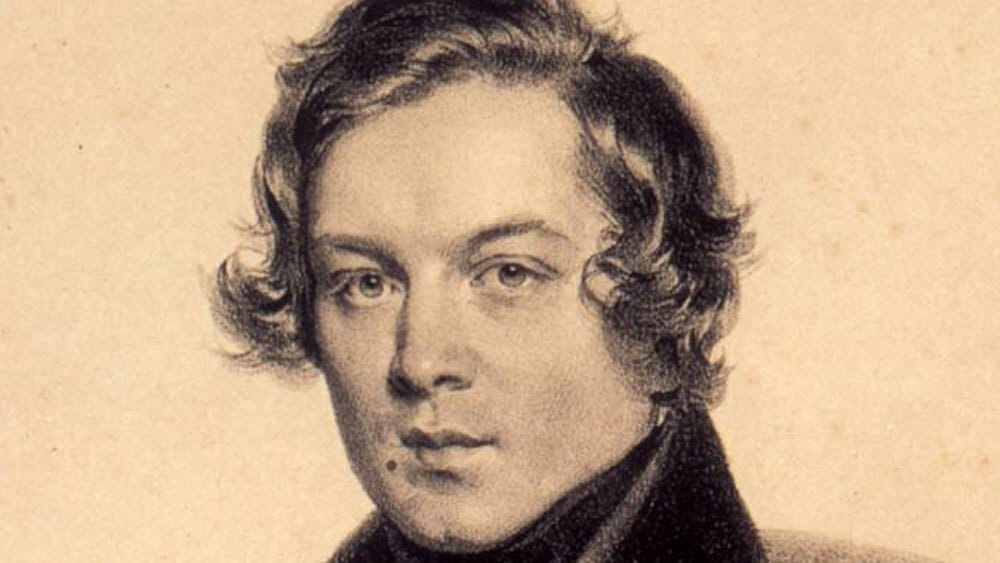Robert Schumann’s New Year Eve

In the good old pre-pandemic days (remember them?), we at Child’s Play would have been resting during the festive season after all the hard work put into our annual Christmas concert earlier in the month of December. One of those concerts featured an arrangement for strings of ‘Silvesterlied’ or ‘New Year’s Eve Song’ by German pianist-composer, conductor and influential music critic Robert Schumann (1810 – 1856).
It is the last work from his Album for the Young (Album für die Jugend), Op. 68, written in 1846. Reading up about this particular opus by Schumann, I realized how apt a selection from it was for a children’s concert.
The financial realities of supporting a household (his wife Clara would only embark on a very successful career touring as a pianist much later) compelled Schumann to think not just of the “artistic fruits” of his labour but more mundane considerations as well.
His piano cycles from the 1830s were seen as eccentric and didn’t go down well with publishers or public.
Furthermore, he realized that there just wasn’t pedagogical piano music of good quality with which to teach his own three daughters. His Album for the Young was one of many that he composed to address this. He initiated a new genre of piano literature, of programmatic music written specially for children and broadened horizons in music education that persist into our time.
The catchphrase of the time was ‘Hausmusik’ (literally music designed for playing at home), replacing the aristocratic salons and palaces of earlier times, or contemporary large public performance spaces. Hausmusik embodied the Enlightenment ideas of self-cultivation, self-education and civic humanism, collectively known as ‘Bildung’ (education).
Schumann’s commitment to Bildung would have come not just from his bookseller-publisher father, but also from his teacher (who would go on to become, reluctantly, his father-in-law as well!) Friedrich Wieck. The three cornerstones of Wieck’s teaching were “the most sensitive listening, the finest taste, and a profound sensibility” as opposed to “absolutely no hearing, perverted taste, and no feeling of any kind.” He spoke out strongly against the “empty virtuosity” and “comfortless plunder and tinsel-playing” of pianists such as Kalkbrenner and Liszt.
Schumann, like Wieck, believed that musical excellence depended upon a proper foundation built from childhood. He compared endless daily hours spent on mechanical exercises to “trying to recite the alphabet faster and faster every day.”
His other aphorisms: “No child can be brought to healthy manhood on sweetmeats and pastry. Spiritual like bodily nourishment must be simple and solid.”
Such aphorisms eventually became part of a long list of “House Rules and Maxims for Young Musicians,” exhorting them to “put virtuosity at the service of artistry.” The initial plan was for the album to have appropriate drawings in the margins, thus “incorporating music, text and illustrations.”
With an eye on the commercial side to the release of the piano album in time for Christmas when it would make the ideal gift to a piano student, Schumann tried to persuade the publisher Breitkopf und Härtel release his Opus 68 as a Weihnachtsalbum für Kinder (Christmas Album for Children).
Unfortunately, the publishers didn’t acquiesce, saying “The market for your compositions is, by and large, rather limited—more limited than you could believe….[W]e have lost through the publication of your works a significant sum and there is at this point little prospect of recovering it.”
Schumann was therefore compelled to release it in the form we recognize today, via another publisher, Julius Schuberth of Hamburg.
The Album has 43 titled character pieces and is divided into two parts, Part I (numbers 1-18), “Für Kleinere,” (“For little children), comprising easier works; and Part II (numbers 19-43), Kleiene Romanzen” (Little Romances) “Für Erwachsenere” (“For Adults”) contains works of greater difficulty.
Suzuki students will be familiar with the tenth work from Part I, ‘Fröhlicher Landmann, von der Arbeit zurückkehrend’ (‘The merry peasant’, returning from work or ‘The Happy Farmer’). It is the sixteenth piece in the Suzuki Book 1.)
Offering the album to a broader audience than just for Christmas allowed it to be sold more generally. For reasons of cost, the idea of individual illustrations to accompany each piece as abandoned. But Schumann managed to persuade the famous illustrator of children’s books, Ludwig Richter, to draw the title page in exchange for twenty-four hours of composition instruction for Richter’s son!
The process of the illustration was also elaborate. Richter went to the home of the Schumanns where Clara played all the pieces of the Opus 68, following which Richter drew vignettes of ten pieces.
Schumann revealed in a letter to his friend Carl Rienecke that he had “never been happier” than when composing these pieces. He further wrote that whereas his earlier piano album ‘Kinderszenen’ (Scenes from Childhood) were “reminiscences written for adults” but that the ‘Album for the Young’ was “written from the perspective of a child.”
Schumann would write later that these pieces “were taken directly from my family life.”
Responding to criticism by the influential reviewer Ludwig Rellstab that music pieces needed no titles (“Music has to be music”), Schumann stood his ground, saying “[t]itles for pieces of music, since they again have come into favor in our day, have been censured here and there, and it has been said that ‘good music needs no sign-post.’ Certainly not, but neither does a title rob it of its value; and the composer in adding one at least prevents a complete misunderstanding of the character of his music. If the poet is licensed to explain the whole meaning of his poem by its title, why may not the composer do likewise?”
A century after its publication, Ernest Hutcheson, president of the Juilliard School wrote in 1948: “Nine-tenths of the “teaching” pieces that flood the market might be thrown into the trash-barrel without a pang to make way for that Golden Treasury of music for children, the 43 Piano Pieces for the Young, Opus 68, familiarly known as the Album for Youth. What a blessing it would be to rid ourselves of the litter-ature of swing songs devoid of swing, cradle songs that don’t rock, skating pieces, pop-guns, and what-not? These are true teaching pieces in the sense that they are written to be taught, not played. They remind me forcibly of a remark made by an angling friend of mine about the array of lures displayed in a sporting-goods shop: that they are manufactured to capture not fish, but the eye of the fisherman. Schumann provides more tempting bait.”
The popularity of Schumann’s ‘Album for the Young’ even today is clear from the arrangements of the melodies for other instruments or combinations of instruments.
The ‘Silvesterlied’ or ‘New Years’ Eve’ song (also sometimes called Wintertime II, as it follows number 42, called ‘Wintertime’) is in binary form, with a five bar and ten-bar section, each repeated twice. They quote two well-known German folk tunes, “Sweet Lovers Love the Spring” and the “Grandfather’s Dance.”
Until we’re safely able to play live for you again, Child’s Play wishes all of you a Happy New Year 2022!
This article first appeared in The Navhind Times, Goa, India.





